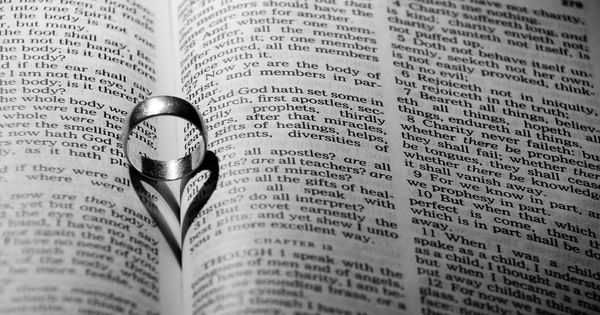Highlights
Religious couples report experiencing their marriage as anchored, sustained, and sanctified in what I’ve described in my clinical research as a “couple-God triangle”1 that is invoked through prayer.2 This divine triangle conveys the couple’s view of God’s influence and investment in their relationship. James L. Griffith offered a metaphor for this unseen relationship:
A therapist who tries to work with a religious [couple] without locating God in [their marital] system may find himself or herself in the position of the astronomers in the mid-1800s who were puzzled that their equations could not predict the movement [of the planets].3
Crunching the numbers led them to speculate the existence of a planet whose gravitational force would account for planetary orbits, and they found Neptune. Similarly, therapists working with religious couples may observe an unexplained gravitational pull on marital interaction and discover that their religious beliefs have made God an integral, even central part of their marital solar system and an unexpected resource for positively shifting marriage interaction.
Researchers have found that prayer’s gravitational pull on the marital relationship includes positive outcomes of forgiveness,4 trust and unity, decreased infidelity,5 and increased relationship satisfaction and commitment, particularly when couples pray for one another (i.e., intercessory prayer).6 Our research shows that prayer7 may also lead to greater mindfulness of the effects of one’s actions on a spouse, a lessening of negative feelings, and “a shift to God’s meta-perspective” and relationship orientation that lessens anger and frustration.8 Prayer can be a self-soothing and de-escalation practice.9 Prayer has also been associated with improved conflict resolution for religious couples.10 Enhanced intimacy, commitment, and communication are also positive effects that prayer appears to confer on a marital relationship.11
Given these potential benefits, it is important to consider how prayer works and under what conditions. Based on research findings from qualitative interviews and survey measurements of religious couples’ experiences with prayer, it may have to do with the gravitational pull on couple interaction that religious couples experience from connecting and communing with God as a personified being possessing specific qualities and interests toward their marriage—a marriage advocate. A religious couple’s experience of God as a transcendent presence and persona appears to be what produces a positive gravitational pull on the couple’s perspective, interaction, and outcome. Thus, the benefits of prayer for marriage are partly a function of a religious couple experiencing their God in very real and specific ways.
Communion with God through prayer has both an immediate and far-reaching influence within a marriage.
Experiencing a Personified Deity
The religious couples we studied experienced their God as a personified being who loves and holds a deep regard for their marriage. Invoking and heightening mindfulness of God through prayer, religious spouses and couples reported experiencing: 1) a deep and caring connection with a God who holds benevolence toward each spouse (relationship); 2) a sense of their God’s care, concern, and commitment to the couple relationship without bias for either spouse (neutrality); and 3) incremental (step-by-step) impressions arising in each spouse regarding how to act to help strengthen the marital relationship (responsibility). In turn, couples experienced an affirmation and restoration of these qualities in themselves that helped them reconnect and positively shift their interaction.
In this manner, for devout religious couples, their God’s transcendent gravitational presence and pull can be felt daily in their relationship. In our research, religious couples reported that prayer invites and invokes their experience of God’s presence and these attributes, which produces an active pull to their better nature, exercising a softening and sanctifying influence that helps them deescalate and engage with renewed relationship regard, neutrality, and responsibility.
In other words, prayer’s success appears to be a function of the couple’s faith and experience that they are invoking a very real “couple-God relationship triangle” with a loving and caring relationship advocate.12 Thereby, connection to and communion with God in prayer has both an immediate and far-reaching influence within a marriage. As their mindfulness of and relationship with God grows, its potential to shift and sanctify the couple relationship is heightened, according to our research.13
Frank Fincham and Ross May found in a 2017 study, for example, that this “divine pull” within couple or family relationships is evidenced in a greater willingness to forgive one another.14 Newer research previously covered on this blog found that there is also a greater capacity and desire to attenuate and alleviate disagreements and tensions.15
Our research shows that prayer may also lead to greater mindfulness of the effects of one’s actions on a spouse, a lessening of negative feelings, and “a shift to God’s meta-perspective” and relationship orientation that lessens anger and frustration.
The Benefits of Prayer for Conflict
As the couple attempts to prevent conflict or repair their relationship, prayer can become an integral part of the process. In separate studies,16 my colleagues and I identified several effects of prayer specific to marital conflict. Couples: 1) experienced relationship mindfulness and accountability; 2) recognized that communion and connection with God in prayer is incompatible with the negativity (hostility, contempt, and anger) they might be feeling and therefore felt nudged to surrender that anger and hostility and open themselves to their partner and toward reconciliation; 3) experienced a diminishing of emotional reactivity and a softening towards one another. Significantly, as partners in these studies felt that God heard and understood them in prayer, there was a subsequent shift from a partner-change focus to a self-change focus in their relationship, and they reported perceiving actions that they could take to help heal their relationship. In this way, our research suggests that prayer promotes relationship regard, neutrality, and responsibility, which marriage therapists relate to positive couple interaction.
The Timing of Prayer
Our observations also indicate that the timing of prayer appears to be important to the benefits couples receive.17 Couples who start their day with relationship-attentive prayer appear more likely to approach disagreements with mindfulness toward caring and conciliation—what John Gottman, Sybil Carrere, and Ellie Lesitsa call “a soft startup position”18—and they are better at avoiding or ameliorating hurtful exchanges. Prayer heightens and confirms their mindful choice regarding how they will interact with and react to each other. In this way, they practice “fire prevention prayer.”
Conversely, other couples pray only after the sparks are flying. Their “stop, drop, and pray” pattern is used as a “fire extinguisher.” Prayer appears to help soothe raw feelings and dissipate emotional reactivity, returning partners more rapidly from a “hot” to a “cool” condition of relationship regard, neutrality, and responsibility. Once emotional regulation and connection are reestablished, and with the help of the couple-God triangle, these couples are able to problem-solve more effectively.
Finally, couples sometimes turn to prayer only after conflict burns itself out. At first, conflict escalates, interaction is volatile, and emotions are reactive, and partners are in no mood to offer relationship regard, neutrality, or responsibility. Anger, hostility, and contempt fuel the fire until partners are exhausted. The pain of attachment rupture can promote a rebound to the relationship and a resort to prayer to “make things better.” This we called “Band-Aid prayer.”
When couples pray only after the sparks fly or use prayer as a Band-Aid, their relationship takes a hit because the chance for avoiding hurt altogether is lost, although prayer does appear to help with post-conflict healing. Still, prayer for mindfulness and prevention clearly delivers the best results.
Conclusion
Research supports that prayer works for religious couples. Couples’ reports show the best timing for prayer. Finally, some studies are beginning to uncover just how prayer works, by invoking for religious couples a therapeutic “couple-God triangle,” an intimate relationship and advocacy that helps mediate conflict and invite and coach resolution. Prayer appears to work as a result of religious couples’ vital experience of their God’s gravitational presence and pull in their marital relationship toward a better way.
Mark H. Butler is a Professor and MFT in the School of Family Life at Brigham Young University. Hannah R. Herring is a graduate of the School of Family Life.
Editor’s Note: The views expressed in this article are those of the authors and do not necessarily reflect the official policy or views of the Institute for Family Studies. This article was updated on March 27, 2019.
1. M.H. Butler & J.M. Harper, "The divine triangle: God in the marital system of religious couples," Family Process, 33, no. 3 (1994): 277-286.
2. M.H. Butler, B.C. Gardner, & M.H. Bird, (1998). "Not just a time-out: Change dynamics of prayer for religious couples in conflict situations," Family Process, 37, no. 4 (1998): 451–478. See also: M.H. Butler, J.A. Stout, & B.C. Gardner, "Prayer as a conflict resolution ritual: Clinical implications of religious couples’ report of relationships softening, healing perspective, and change responsibility," The American Journal of Family Therapy, 30 (2002): 19–37.
3. J.L. Griffith, (1986). "Employing the God-family relationship in therapy with religious families," Family Process, 25 (1986): 609–618.
4. F.D. Fincham & R. W. May, "Prayer and forgiveness: Beyond relationship quality and extension to marriage," Journal of Family Psychology, 31, no. 6 (2017): 734-741.
5. N. Reich & S.M. Kalantar, "The role of praying for the spouse and sanctification of marriage in reducing infidelity," Mental Health, Religion & Culture, 21, no. 1 (2018): 65-76.
6. F.D. Fincham & S.R. Beach, "I say a little prayer for you: Praying for partner increases commitment in romantic relationships," Journal of Family Psychology, 28, no. 5: 587-593.
7. Our research globally included the sanctifying effects of any of the following: (a) individual prayer, (b) couple conjoint prayer, or (c) individual or conjoint intercessory prayer.
8. Butler et al., 1998; Butler et al., 2002.
9. Ibid.
10. Ibid.
11. Butler et al., 1998.
12. Butler & Harper, 1994.
13. Butler et al., 1998; Butler et al., 2002.
14. Fincham & May, 2017.
15. J.M. Chelladurai, D.C. Dollahite, L.D. Marks, “'The family that prays together . . .:' Relational processes associated with regular family prayer,'" Journal of Family Psychology, 32, no. 7 (2018): 849-859.
16. Butler et al., 1998; Butler et al., 2002.
17. Ibid.
18. S. Carrere & J.M. Gottman, "Predicting divorce among newlyweds from the first three minutes of a marital conflict discussion," Family Process, 38, no. 3 (1999): 293–301. See also: E. Lisitsa, "How to fight smarter: Soften your start-up," The Gottman Institute Blog, 3/15/2013















